 |
Hydrogen Production from Methanol and Water at Low Temperature by Atomic-scale Dispersion of Platinum-Molybdenum Carbide Catalysts
Hydrogen can be regarded as the next generation of secondary clean energy, but the storage and transportation of hydrogen has been a bottleneck for the large-scale application of hydrogen energy. In particular, hydrogen fuel cells are the most promising next-generation energy delivery system, which efficiently converts chemical energy into electrical energy and are widely used in aerospace, automotive, and other fixed and mobile energy supply systems, but hydrogen chemistry is lively. Hydrogen storage has become the key to hydrogen fuel cell applications. At present, Toyota's commercial hydrogen fuel cell vehicle solution uses hydrogen cylinders with a capacity of approximately 120 L and pressures up to 700 kg for hydrogen storage. However, its safety is not optimistic, and there are also hidden risks in the construction of hydrogen infrastructure in the city. In addition, other current hydrogen storage systems are either expensive or have limited storage capacity. In response to these deficiencies, one possible solution is to store hydrogen in liquid methanol, generate hydrogen in-situ by the liquid-phase reforming reaction of water and methanol, and use the fuel cell to release the stored hydrogen in methanol. Equimolar water releases additional hydrogen.
Recently, the Martin Group of the School of Chemistry and Molecular Engineering of Peking University cooperated with Zhou Wu of the University of Chinese Academy of Sciences, the Institute of Coal Chemistry of the Chinese Academy of Sciences, Wen Xiaodong of the Chinese Academy of Sciences, and the Sichuan University of Dalian University of Technology to collaborate on the hydrogen production of methanol and water in the liquid phase. Characteristics: A new platinum-molybdenum carbide dual-function catalyst has been developed, achieving extremely high hydrogen production efficiency at low temperatures (150-190oC). There is a very strong interaction between platinum (Pt) and molybdenum carbide (MoC) substrates, allowing platinum to atomically disperse on the surface of molybdenum carbide nanoparticles, creating a high density of atomic-scale catalytically active centers. Activation of water is accomplished in the center of molybdenum carbide, and methanol activation occurs in the platinum center. The synergy between the atomic-scale highly dispersed Pt center and the molybdenum carbide substrate enables efficient activation of the reaction intermediate at the interface between the two, resulting in an overall high hydrogen production activity in methanol and aqueous liquid phase reactions. At a temperature of 150 degrees Celsius, hydrogen can be released at a reaction rate of 2,276 molH2/(molPt*h), further increasing the temperature to 190 degrees Celsius, and the hydrogen release rate can reach 18,046 molH2/(molPt*h), which is higher than that of conventional platinum-based catalysts. Nearly two orders of magnitude. At the same time, the atomic-scale dispersion characteristics can maximize the utilization rate of platinum in precious metals. With the hydrogen production activity estimated, only 6 grams of platinum can be used to make the hydrogen production rate reach 1 kgH2/h, basically satisfying the commercial vehicle fuel. Battery pack requirements. Based on the current methanol market price (2,400 yuan/ton), using this technology path to store and release hydrogen, the fuel price per 100 kilometers of hydrogen fuel cell vehicles is only about 13 yuan, and 60-80 liters of methanol can be used for domestic cars. - 1,000 kilometers. The research work has established a new chemical efficient hydrogen storage system, which provides a new idea for the in-situ hydrogen supply of fuel cells and is expected to be used as the next generation of new hydrogen storage systems with high efficiency. This research was published on Nature, March 23, 2017 under the title "Low-temperature hydrogen production from water and methanol using Pt/α-MoC catalysts" (doi:10.1038/nature21672).
The American Chemical Society's C&E News magazine highlighted the work with the title "New process for generating hydrogen fuel." Professor Dion Vlachos, Director of the Energy Center at the University of Delaware, commented on the new process “has a technological edgeâ€; Professor Matthias Beller, Director of the Leibniz Catalysis Institute, considered this catalytic system to be a A major breakthrough (Beller calls Ma\s catalyst “a major breakthroughâ€). Such catalysts are also expected to play an important role in the catalytic hydrogen production of other aqueous phase reforming processes such as domestic wastewater and ethanol.
GUANGDONG LAVIUS LIGHTING CO., LTD. , https://www.laviuslighting.com